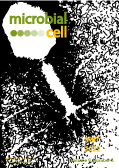Table of contents
Volume 9, Issue 5, pp. 103 - 125, May 2022
Cover: Artistically altered electron micrograph of an Escherichia-Virus T4, a DNA bacteriophage that is only capable to engage in the lytic (but not the lysogenic) lifecycle (image by 7USSR7 retrieved via Wikimedia Commons and modified by MIC). The cover is published under the Creative Commons Attribution (CC BY) license.
Enlarge issue cover
Air- and dustborne fungi in repositories of the National Archive of the Republic of Cuba
Sofia Borrego, Isbel Vivar and Alian Molina
Research Articles |
page 103-122 | 10.15698/mic2022.05.776 | Full text | PDF |
Abstract
This study has as objectives to determine the concentration and diversity of the air- and dustborne mycobiota in seven National Archive of the Republic of Cuba repositories, and to assess the potential risk of biodeterioration that isolated taxa may have. In the indoor and outdoor environmental microbiological samplings a SAS biocollector was used and the indoor/outdoor (I/O) ratio was determined for each repository. The settled dust was collected during six months. Sørensen’s coefficient of similarity (QS) was calculated to compare the isolated taxa among the three studied niches (indoor air, dust, outdoor air). The biodegradation potential of the isolated taxa was determined by semi-quantitative tests. The concentrations in the air of repositories with natural cross-ventilation ranged from 225.2-750.3 CFU m-3, while in the Map library with air-conditioning the concentration was significantly lower. The I/O ratios ranged from 0.1-1.7 revealing different environmental qualities. The maximum settled dust load was 22.8 mg/m2/day with a top fungal concentration of 6000 CFU g-1. 14 and eleven genera were detected in the air and dust respectively with predominance of the genera Aspergillus, Cladosporium and Penicillium. A QS of 0.8 was obtained between the indoor and the outdoor environments with eleven taxa similar evidencing the incidence of outdoors on the indoor mycobiota. The isolated taxa showed several biodeteriogenic attributes highlighting twelve and 14 taxa from indoor air and dust respectively with positive results for the five tests performed. This demonstrates the potential risk that fungal environmental represent for the preserved documentary heritage.
Fatty acid metabolism of Mycobacterium tuberculosis: A double-edged sword
Camila G. Quinonez, Jae Jin Lee, Juhyeon Lim, Mark Odell, Christopher P. Lawson, Amarachukwu Anyogu, Saki Raheem and Hyungjin Eoh
Microreviews |
page 123-125 | 10.15698/mic2022.05.777 | Full text | PDF |
Abstract
Unlike other heterotrophic bacteria, Mycobacterium tuberculosis (Mtb) can co-catabolize a range of carbon sources simultaneously. Evolution of Mtb within host nutrient environment allows Mtb to consume the host’s fatty acids as a main carbon source during infection. The fatty acid-induced metabolic advantage greatly contributes to Mtb’s pathogenicity and virulence. Thus, the identification of key enzymes involved in Mtb’s fatty acid metabolism is urgently needed to aid new drug development. Two fatty acid metabolism enzymes, phosphoenolpyruvate carboxykinase (PEPCK) and isocitrate lyase (ICL) have been intensively studied as promising drug targets, but recently, Quinonez et al. (mBio, doi: 10.1128/mbio.03559-21) highlighted a link between the fatty acid-induced dormancy-like state and drug tolerance. Using metabolomics profiling of a PEPCK-deficient mutant, Quinonez et al. identified that over-accumulation of methylcitrate cycle (MCC) intermediates are phenotypically associated with enhanced drug tolerance against first- and second- line TB antibiotics. This finding was further corroborated by metabolomics and phenotypic characterization of Mtb mutants lacking either ICL or 2-methylcitrate dehydratase. Fatty acid metabolism induced drug-tolerance was also recapitulated in wildtype Mtb after treatment with authentic 2-methylisocitrate, an MCC intermediate. Together, the fatty acid-induced dormancy-like state and drug tolerance are attributed to dysregulated MCC activity.










